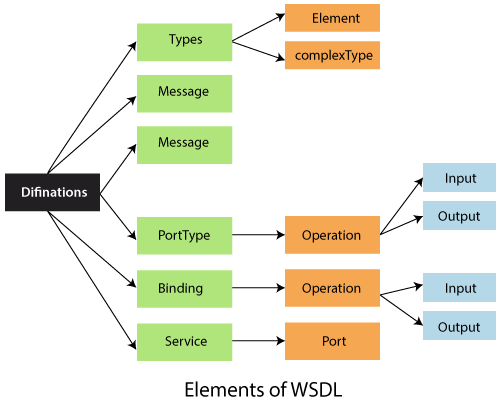Web Services Components
There are two components of web services:
- Web Service Description Language (WSDL)
- Universal Description Discovery and Integration (UDDI)
Web Service Description Language (WSDL)
WSDL acronym for Web Service Description Language. WSDL is an XML based interface description language. It is used for describing the functionality offered by a web service. Sometimes it is also known as the WSDL file. The extension of the WSDL file is .wsdl. It provides the machine-readable description of how the service can be called, what parameter it expects, and what data structure it returns.
It describes service as a collection of network endpoint, or ports. It is often used in combination with SOAP and an XML schema to provide XML service over the distributed environment. In short, the purpose of WSDL is similar to type-signature in a programming language.
The current version of WSDL is 2.0. Version 1.1 does not endorse by W3C.
Elements of WSDL
| WSDL 1.1 Term | WSDL 2.0 Term | Description |
|---|---|---|
| Service | Service | It is a set of system functions. |
| Port | Endpoint | It is an endpoint that defines a combination of binding and network addresses. |
| Binding | Binding | It specifies the interface and defines the SOAP binding style. It also defines the operations. |
| PortType | Interface | An abstract set of services supported by one or more endpoints. |
| Operation | Operation | Abstract detail of an action supported by the service. It defines the SOAP actions and the way of encoding the message. |
| Message | N/A | An abstract, typed definition of data to communicate. W3C has removed the message in WSDL 2.0, in which XML Schema types for defining bodies of inputs, outputs, and faults are referred directly. |
| Types | Types | It is a container for data type definition. The XML Schema language (XSD) is used for this purpose. |

Universal Description, Discovery, and Integration (UDDI)
UDDI acronym for Universal Description, Discovery, and Integration. It is an XML-based registry for businesses word wide to list themselves on the internet. It defines a set of services supporting the description and discovery of the business, organizations, or other web service providers. The UDDI makes the services available and the technical interfaces which may be used to access those services.
The idea behind UDDI is to discover organizations and the services that organizations offer, much like using a telephone directory. It allows the business to list themselves by name, product, location, or the web service they offer. A UDDI works in the following manner:
- A service provider registers its business with the UDDI registry.
- A service provider registers each service separately with the UDDI registry.
- The consumer looks up the business and service in the UDDI registry.
- The consumer binds the service with the service provider and uses the service.
The UDDI business registry system has three directories are as follows:
- White Pages
- Yellow pages
- Green Pages
White Pages: The white pages contain basic information such as company name, address, phone number, and other business identifiers such as tax numbers.
Yellow Pages: The yellow pages contain detailed business data organized by relevant business classification. The version of the yellow page classifies business according to the newer NAICS (North American Industry Classification System).
Green Pages: The green pages contain information about the company’s crucial business process, such as operating platform, supported programs, and other high-level business protocols.
